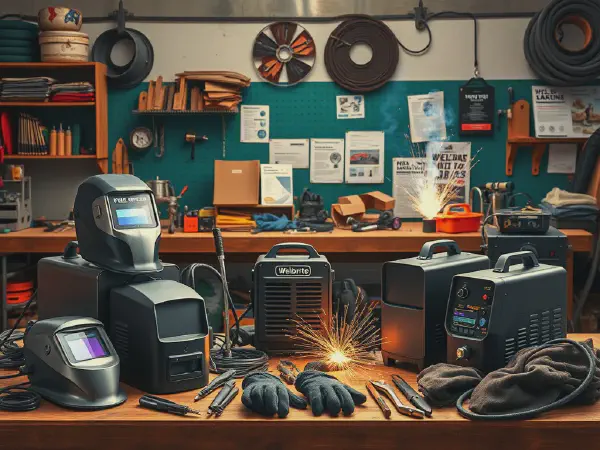Explore the Top Rated Welding Kits for Beginners Today!

Guide to Welding Kits: Types, Features, Brands, and Maintenance
Welding kits are essential tools for anyone looking to engage in welding, whether for professional or hobbyist purposes. These kits typically come with all the primary components needed for various welding processes and can vary widely in complexity and features. Understanding welding kits can help you choose the right one for your specific needs, ensuring quality work and safety during the welding process.
The variety of welding kits available caters to different skill levels, material types, and welding techniques. From beginner-friendly options to advanced multi-process welders, these kits simplify the welding experience. By having the right tools at your disposal, users can efficiently complete projects ranging from repairs to fabrications, making welding kits indispensable for metalworking.
When selecting a welding kit, one should consider several factors, including the type of welding, portability, and whether safety gear is included. Each kit is designed for specific kinds of welding, such as MIG, TIG, or stick welding, which dictate how the user will operate the equipment. Additionally, many welding kits come with accessories that enhance their usability and ensure safety throughout the process.
Safety remains a crucial aspect of welding, and investing in a high-quality welding kit can significantly affect the quality of the welds and the safety of the operator. By choosing kits that offer essential features and safety gear, welders can reduce the risk of accidents and improve their skill over time. With advancements in technology, modern welding kits are available with numerous features that enhance performance and durability.
In summary, understanding various types of welding kits, their essential features, the best brands, and maintenance tips can help you make informed decisions whether you're a beginner or an experienced welder. This guide aims to equip you with the necessary knowledge to navigate the world of welding kits confidently.
Types of Welding Kits
MIG welding kits are an excellent choice for beginners due to their simplicity and ease of use. MIG stands for Metal Inert Gas, and this process uses a continuous wire feed to create a weld pool. Many MIG welding kits come with gas tanks, regulators, and everything you need to begin welding. They're ideal for thin metals and are commonly used in automotive repairs and fabrication projects.
TIG welding kits offer an advanced options for those looking for precision in their welding projects. TIG, or Tungsten Inert Gas, uses a non-consumable tungsten electrode to produce the weld. These kits allow welders to have greater control over the heat and the welding filler material. While more challenging to master than MIG welding, TIG welding kits are preferred for high-quality welding on materials like aluminum and stainless steel.
Stick welding kits are often the go-to choice for heavy-duty welding tasks. Using a consumable electrode that melts and joins with the workpiece, stick welding can be performed on thicker metals and in outdoor conditions. It is commonly used in construction and heavy fabrication, making stick welding kits both effective and versatile for various applications.
Multi-process welding kits provide versatility by allowing users to perform different welding techniques such as MIG, TIG, and stick welding with a single machine. These kits are equipped with multiple settings and functionalities, catering to different welding needs. Although they can be more expensive, they save space and offer great flexibility for welders who work on various projects.
Essential Features of Welding Kits
Safety gear is critical in any welding kit, and it's advisable to check that the kit includes essentials like gloves, helmets, and protective clothing. From sparks to intense light, welding can be hazardous to your skin and vision. High-quality welding kits will prioritize safety by providing necessary protective equipment and ensuring the user's well-being during the welding process.
Power output and performance are vital when choosing a welding kit. The amperage capacity of the welder often determines its ability to handle different materials and thicknesses. A good welding kit should provide sufficient power to suit your intended welding tasks, while also ensuring stable performance to produce clean and strong welds without excessive spatter.
Welding accessories and tools enhance the welding experience, making your kit more functional. Items like clamps, welding pliers, and cleaning brushes are often part of comprehensive kits. These accessories assist in achieving precise welds and maintaining the welder, allowing for a smoother workflow and more gratifying outcomes in your projects.
Portability and storage options can often be overlooked but are essential for many welders. If you plan on transporting your welding kit to various job sites or need to store it efficiently, look for lightweight designs with built-in storage solutions. Many modern welding kits come in easy-to-carry cases, allowing for both mobility and organization of all your welding equipment.
Top Brands of Welding Kits
Popular MIG welder brands include Lincoln Electric, Miller Electric, and Hobart. These brands are well-known for their durable machines that cater to both beginners and advanced welders alike. Each of these brands offers a range of models that vary in terms of power, portability, and additional features, making it easier to find a MIG welder that suits your needs.
Best TIG welder manufacturers such as Everlast, CK Worldwide, and Eastwood provide high-stquality TIG welding machines that cater to both professionals and hobbyists. They offer a variety of features and settings, ensuring precise control for a wide range of materials and thicknesses, making them ideal for artists, metal sculpture enthusiasts, and metal fabricators.
Reliable stick welding equipment can be found from brands like Forney, Weldpro, and Century. Known for manufacturing durable and dependable stick welders, these brands offer a range of options suited for both beginners and those seeking industrial-grade performance. Their machines are capable of handling a variety of materials and thicknesses, skillfully adhering them together effectively.
Comparing multi-process welder brands is essential for welders looking for versatility in their kits. Popular brands like Lincoln Electric, Miller Electric, and Hobart also offer multi-process models that combine the features of MIG, TIG, and stick welding. These brands are renowned for their reliability and innovation, which provides great choices for users wanting to perform multiple welding processes with one machine.
Beginner Tips for Choosing Welding Kits
Understanding your welding needs is crucial when selecting a welding kit. Consider the materials you'll be working with, the thickness of those materials, and your experience level. By aligning your specific requirements with the appropriate type of welding kit, you'll be better positioned to make the right choice and produce successful welds.
Budgeting for your first welding kit involves evaluating your needs while considering the potential costs. Entry-level welding kits may be more affordable, but investing in a higher-quality kit can save you money in the long run. Additionally, factor in the costs of maintenance and accessories when determining your budget for the overall welding experience.
Evaluating kit specifications is essential to ensure you select a welding kit that suits your skill level and project requirements. Review the power output, welding techniques offered, and included accessories in the kit. Paying attention to these details can prevent poor performance and enhance your welding capabilities.
Reading customer reviews and ratings provides valuable insight into the performance of various welding kits. Look for feedback regarding ease of use, reliability, and customer support when evaluating options. High ratings and positive customer experiences can lead you to the ideal welding kit that meets your expectations.
Maintenance of Welding Kits
Cleaning your welding equipment on a regular basis is vital for maintaining its performance and longevity. Ensure that all parts, including cables and hoses, are free from excessive dirt, grime, or spatter build-up. Deep cleaning your welder, particularly the contact tips and nozzles, will help provide better electrical conductivity and cleaner welds over time.
Regular maintenance tips include checking for wear and tear and testing the power output of your machine. Keeping a log of your maintenance activities and any repairs made can also be useful. Pay attention to signs of damage or malfunction, and address them promptly to avoid further complications during welding operations.
Troubleshooting common issues is an essential skill for any welder. Familiarize yourself with common problems such as inconsistent arc performance, excessive spatter, and feed issues. By understanding these potential challenges, you can quickly identify and resolve issues, ensuring better quality in your welding projects.
Knowing when to replace welding kits is crucial for both performance and safety. Signs of wear, frequent malfunctions, or outdated features can indicate the need for a new kit. Recognizing these signs early can help you stay ahead of potential issues and work with reliable, efficient equipment for all your welding tasks.
